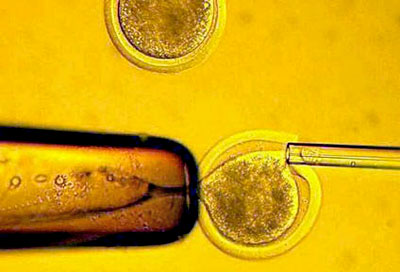|

by Kelley Bergman
April 22, 2012
from
PreventDisease Website
|
Kelley Bergman is a
media consultant, critic and geopolitical investigator.
She has worked as a
journalist and writer, specializing in geostrategic
issues around the globe. |
The first human eggs grown from human stem cells could be fertilized
with human sperm cells later this year, potentially adding one more
peg in the ladder toward reproduction sans human interaction.
In this case it would entirely bypass a
woman's donation of her eggs. But it could also turn stem cells into
an infinite loop, of egg cells into embryos into stem cells, and on
and on, in a fractal-like repetition of reproduction.

In February, a study was announced
involving Japanese women whose reproductive stem cells were donated
because they were undergoing gender reassignment surgery.
Researchers at Massachusetts General
Hospital were able to
coax these ovarian stem cells into becoming
immature human egg cells, which were then incubated in mice so
they’d have the proper ovarian structures. Now these same
scientists, working with a team at Edinburgh University, want to
fertilize them.
After sperm implantation, the scientists would watch the blastocysts
develop into embryos for two weeks - the legal limit - and determine
if they’re viable.
Then these embryos would either be
frozen or "allowed to perish," according to
the Independent. The
tests would validate the stem-cell-derived human eggs, more properly
called oocytes, and could serve as an early indicator of whether
they could be used to eradicate human sexual activity and
infertility.
Stem-cell derived oocytes could replenish the stocks of women
undergoing menopause, or they could be used to allow infertile women
to reproduce. The Independent goes so far as to mention an “elixir
of youth,” wherein women of any age are full of stem-cell derived
oocytes, remaining fertile and youthfully healthy forever.
The scientists argue that using stem cells to grow eggs in lab
dishes might one day help preserve cancer patients' fertility.
Today, Woodruff's lab and others freeze
pieces of girls' ovaries before they undergo fertility-destroying
chemotherapy or radiation. They're studying how to coax the immature
eggs inside to mature so they could be used for in vitro
fertilization years later when the girls are grown.
Still, this potential stem cell-based embryo construction still
faces some hurdles -- reproductive biologists are applying for a
license to the Human Fertilization and Embryology Authority in the
UK. But if it’s approved, the eggs could be fertilized this year,
according to the Independent.
Stem cells on one hand hold such great promise because they can
differentiate into any cell, potentially replacing neurons, islet
cells, kidney cells and more.
On the other hand
serious ethical questions are being raised as to
the source and procurement of the stem cells. While some experts in
the medical community forecast unlimited potential for fetal tissue
technology, others have expressed deep concern as to the limits to
the ethical and moral dynamics of the issue.
This research conceivably turns stem cells into an infinite supply
of cellular material.
The stem cell eggs may be used to help
women conceive a child, but it’s not a huge leap to much more
frightening scenarios:
Stem cells turned into human egg
cells, which could be fertilized to grow embryos, which would
contain more stem cells, which could in turn be harvested... and
so on, as self-contained stem cell factories.
Sources
|

